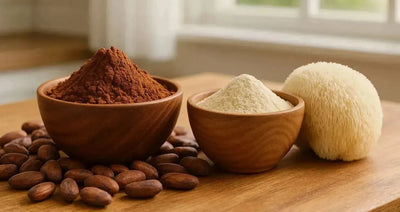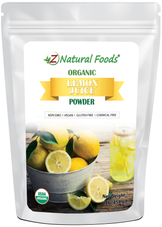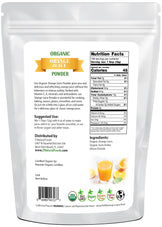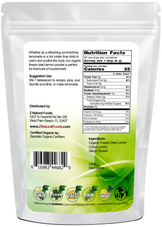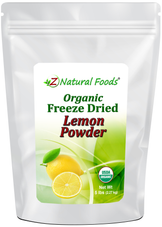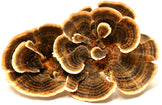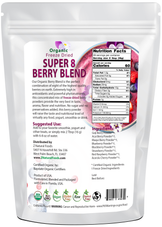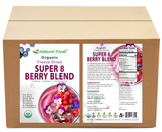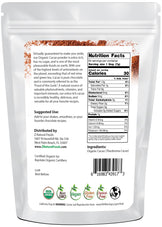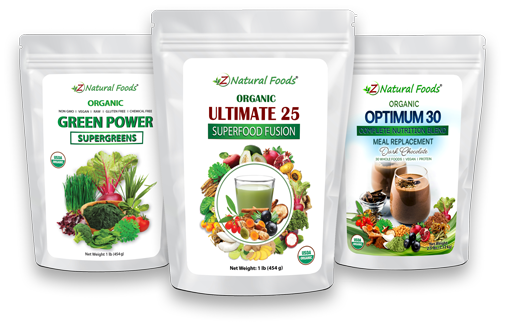Description
Description
To answer the question, “What makes a powdered food more nutrient-dense?” accurately, it is vital first to understand how the term ‘nutrient density’ is defined regarding powdered foods.
First, it is essential to note that powdered foods offer much more than just nutrient density; however, we will discuss some other qualities food powders bring to the table in future articles.
Nutrient density in this situation refers to the result of various processes that filter or dry food and remove the water content, producing a powder that is a more concentrated version of that food.
The fresh and dried versions of wholesome foods contain a treasure trove of nutrients and compounds vital for optimal well-being, providing synergy from the whole food matrix.
For all the complaining we hear and read on the internet about all the problems in our world, now is one of the best and most unique times to be alive.
While technology has many pitfalls, we would not have some fantastic extraction and preserving techniques to create products using these unique food powders without it.
Many health experts believe a diet focused on high amounts of compounds like flavonoids is critical to supporting a healthy aging process because these compounds are known as nature’s biological response modifiers. There are over 8,000 different types of flavonoids found in nature. Based on the research, it does not seem to matter if you acquire them from food or supplements; what counts is the total daily amount you consume.
These experts believe we should consume 500 to 2000 milligrams of flavonoids daily sourced from various foods and supplements: Berries, cacao, and green tea, just to name a few. While results vary based on numerous factors, the USDA Database is one of the most reliable sources for flavonoid content.
A randomized controlled trial discussing how flavonoid-rich foods improve microvascular reactivity and inflammatory status in men at risk for cardiovascular disease showed the following:
- The high-flavonoid (HF) fruit and vegetable (F&V) diet increased endothelium-dependent microvascular reactivity
- Reduced C-reactive protein and vascular cell adhesion molecule
- HF F&Vs increased plasma nitric oxide (NO) in the group as a whole.
Therefore, the following was concluded: “These data support recommendations to increase F&V intake to ≥ 6 portions daily, with additional benefit from F&Vs rich in flavonoids, particularly in men with an increased risk of CVD.”
Drying and Filtering process of nutrient-dense food powders
Next, let's discuss some of the drying and filtering processes that create these various versions of nutrient-dense food powders.
Ultimately, these processes remove the water, fluid, or some other aspect of the food to produce the powder that makes them more nutrient-dense. It is essential to note that we don’t use the term “unprocessed” to define a food powder because everything goes through some processing to create an end product.
Drying, blending, and cooking are all processes that change (often for the better) some aspects of the final food product.
For example, those who are lactose intolerant may not be able to use a concentrated form of whey protein. Those individuals may be able to use an isolated version of whey protein, which goes through a specific filtration process removing the lactose but still contains a nourishing level of important compound found in whey concentrate.
However, whether using a low temperature, shade, air, sun, or freeze-drying process, the quality of the raw materials predominantly determines the final product.
Unlike many other food preservation practices, where unhealthy preservatives are added, freeze-drying and air-drying are all about what is removed: the water. A freeze-dried product has an average of only 3% or less moisture content, and an air-dried product has an average of only 5% or less. Therefore, both of these drying processes allow for greater versatility of the end product due to more accessible storage options and blending capability, as well as supporting the natural flavor profile of the fresh food version. It is vital to understand that each type of food may respond better than others to one of the different drying or filtration processes.
A randomized control trial looking at the effects of consuming freeze-dried strawberries to lower serum cholesterol and lipid peroxidation in adults with abdominal adiposity and elevated serum lipids determined the following:
- The group that received a high dose of freeze-dried strawberries experienced a more significant decrease in total and LDL cholesterol.
- Both dosage groups showed a similar decrease in markers of cellular oxidative damage.
There are six primary advantages to creating a powered food using these methods:
- They create the closest end product when presenting a whole food complex.
- They create a food product closest to the smell, taste, and texture of the fresh version of a food.
- They allow you to customize your needs when creating a product. For example, freeze-dried foods can be left whole, chopped, or milled into a powder, all of which will still offer the nutritional value that comes from the fresh version.
- Air-drying specific foods like apples better retain cellular texture and create a better mouthfeel.
- The end product allows for greater versatility.
- Low heat filtration allows for the creation of a food product that those with specific food intolerances may otherwise use.
Whole food powders vs. Juice / extract powders
As you search online or in the isles of a health store, you may notice a wide array of juice or extracted foods in powder form.
When comparing these versions of food, extract and juice powders undergo further processing to create a more highly concentrated food product.
Extract and juice powders undergo an extraction process that removes the fiber, leaving a highly concentrated level of compounds in the food. For this reason, a juice or extract powder would undoubtedly be considered more “medicinal.” Please take note of the following essential points:
- The umbrella term extract describes various highly concentrated variations that create unique variables for how these powerful foods are potentially used for their nourishing qualities.
- If the food has been standardized, to which specific constituents?
- Isolated standardized extracts separate and focus on a particular family of compounds. It is essential to understand that isolated standardization does not produce a well-balanced end product but may provide a more targeted approach for a specific purpose.
- Finally, please note the concentration level if presented as a full spectrum extract.
The fiber removal aspect has advantages and disadvantages. When the fiber is removed, you no longer have a genuinely whole food product.
The fiber within food is an essential part of the whole food matrix, containing compounds that can affect how that food performs and affect various aspects of metabolic health, including digestion and blood sugar.
For example, a study discussing the polysaccharide K from turkey tail mushrooms showed that isolated lipase reduced the immunological response of PSK by 80%. This shows the importance of the associated lipids bound to the beta-glucans and that their independent presence is insufficient to obtain maximal benefits.
In conclusion, while it is true that eating a powder version is not the same as eating fresh food, the idea that we can’t replace fresh food with a powder to nourish our body is simply untrue.
As stated throughout this article, the powdered version has many significant advantages, with nutrient density and versatility among the many positive attributes. These attributes are critical when applying their limitless applications.


